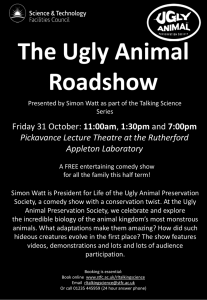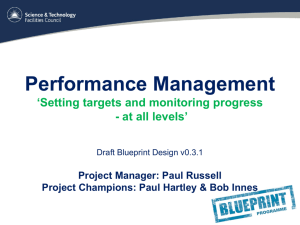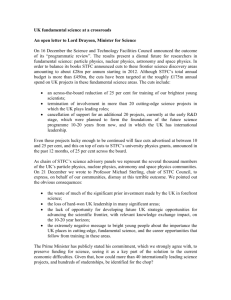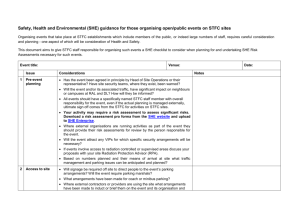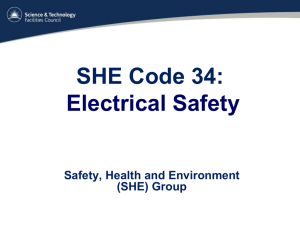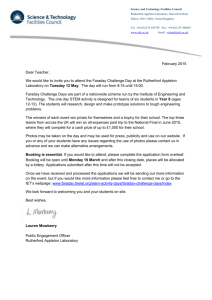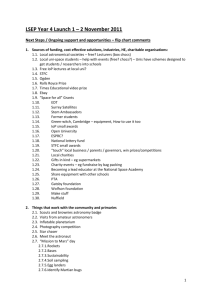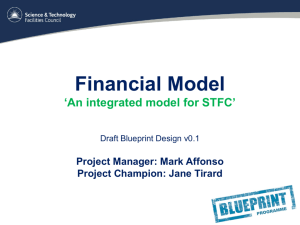STFC PowerPoint template
advertisement
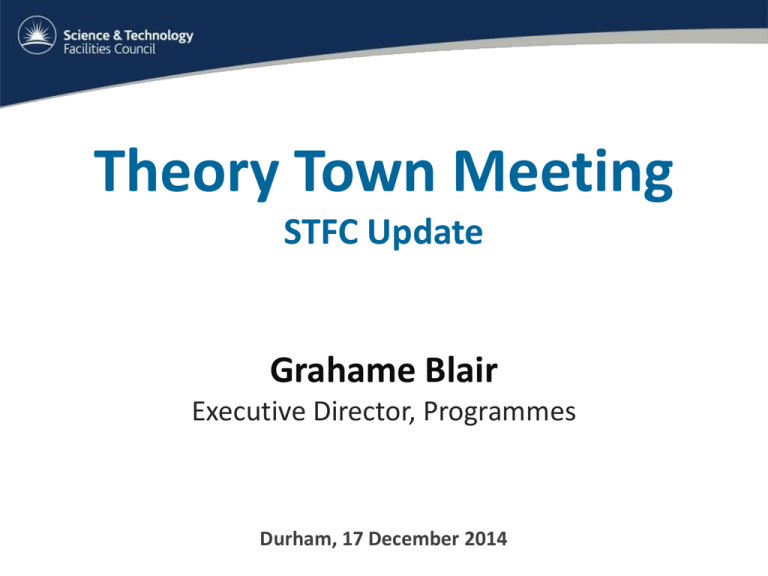
Theory Town Meeting STFC Update Grahame Blair Executive Director, Programmes Durham, 17 December 2014 1. Science highlights 2. Corporate update 3. Particle Physics Programme 4. Discussion CERN • LHC experiments very active – ATLAS has 360 papers published in learned journals, including 70 in last six months • Detailed analysis of Higgs boson properties – Is it the standard model Higgs or something else? – Is it really responsible for giving particles mass? – How does it connect to what we know from cosmology (inflation, dark matter, dark energy)? • Preparing for LHC start-up in 2015 – Long shutdown work has gone extremely well – Next run will be at double the energy and much higher collision rate – Key objectives – better measurement of Higgs properties, search for new particles that may explain Dark Matter RD53 Collaboration General Meeting 16-17 October New research and development collaboration to address the challenges of making readout microelectronics for the phase 2 pixel detector upgrades of ATLAS and CMS Even bigger colliders? • STFC Accelerator Science and Technology (ASTeC), with the University of Dundee, developed laser manipulation process to generate low secondary electron yield (< 1) for metal surfaces • Solves a problem that will be critical for LHC upgrades and for future higher energy machines • Collaboration with industry supported by STFC proof of concept grant • High performance, low cost and rapid atmospheric treatment • Joint patent application filed in July Inspiring future generations • Through our engagement programmes in 2013, we reached 18,000 teachers, 334,000 students and 1.1 million public • We have invested £22.4 million in postgraduate training in particle physics, nuclear physics and astronomy – Current cohort of 766 PhD students – Trained in high-end scientific, analytical and technical skills, which drive the knowledge economy • STFC provided 14,200 training days to students (30% increase on last year) Particle Physics Masterclasses In March, STFC hosted seven days of Particle Physics Masterclasses for over 1,000 A-level students, giving them a unique insight into the real world of particle physics research • 7% increase in applications to physics degree courses. 64% increase between 2008 and 2013 • 84 million members of the public reached through four STFC mass media initiatives between 2009 and 2014 Pledge to get more women into science and technology STFC has answered Government’s call to action by pledging support for its ‘Your Life’ campaign Launched in May 2014, the campaign aims to encourage more women to take up careers in science, technology, engineering and maths (STEM) Public Engagement Highlights • Past – Levitation demonstration on Qi reaches 1.89M viewers on the night • Present – Illuminating Atoms photo exhibition at the Royal Albert Hall • Future – ‘Dark Matter Garden’ is accepted for Chelsea Flower Show 2015 Refreshing our Science Programme Implementing the Programmatic Review • • • • Cherenkov Telescope Array Dark Matter Long Baseline Neutrino Experiments Large Synoptic Survey Telescope Budgets for 2015/16 allocated in accordance with this plan Support for • ALICE Upgrade Nuclear Physics – Central trigger processor and tracking • ISOL-SRS – Internal and external spectrometers • Jefferson Laboratory Upgrade – SuperBigBite spectrometer and forward trigger for CLAS • AGATA – First in-beam test successful, experiment early 2015 • New nuclear physics theory group at the University of York – STFC-funded theory chair and PhD studentship with university funding for additional lecturer Accelerator Science and Technology First electron diffraction demonstrated on VELA • Result has huge scientific potential, enabling atomic scale measurement of fundamental processes in determining mechanical, electrical, catalytic and optical properties of matter • Technique complements the structural science capability of the next generation, large X-ray Free Electron Lasers UED pattern from Au crystal obtained with multiple shot, 4 MeV electrons First electron beam for wastewater treatment • Part of a CLASP-funded collaboration with Oxford/Bristol/Lancaster universities and Siemens 30 years of neutrons at ISIS This week we are celebrating 30 years of neutrons at ISIS: • 24,000 proposals • 114,000 days of neutron and muon instrument time requested • 60,000 experiment days delivered • 13,000 separate experiments • 30,000 Gb of data • Over 10,000 publications STFC Photowalk 2014 Winner: ‘The Polref instrument in ISIS Target Station 2 takes centre stage’ by John Willoughby Keeping airports and passengers safe • STFC spin-out Cobalt Light Systems has now sold its unique liquids scanners to 65 European airports • Identifies, within seconds, the chemical composition of liquids sealed within non-metallic containers without opening them • Presented with the prestigious 2014 MacRobert Award for engineering innovation • Could end hand luggage restrictions 50 years of STFC scientific computing ATLAS computer laboratory 1964 Ferranti ATLAS 0.350 MIPS (A5 chip in an iPhone 4S = 1,256 MIPS) Raising the profile of science • New graphics commissioned – to help explain key LHC concepts • Return of the LHC tunnel – LHC Roadshow Version 2 to engage public around LHC restart • Lasers Roadshow for International Year of Light 2015 – STFC leading, working with EPSRC and other Research Councils supporting, for national tour Impact Report 2014 • Our research remains amongst the best in the world as measured by citation impact – We consistently outperform other areas of physical sciences in the UK in terms of research quality – Over 4,000 peer-reviewed papers published across our entire funding portfolio • Our research produces significant impacts, for example this year… – We have detected the earliest stages of eye disease, made a breakthrough in the race to solve antibiotic resistance, and supporting carbon capture to help UK meet its greenhouse gas emissions target 1. Science highlights 2. Corporate update 3. Particle Physics Programme 4. Discussion STFC’s role Our mission is to maximise the impact of our knowledge, skills, facilities and resources for the benefit of the United Kingdom and its people. We deliver our mission through three distinct but interrelated long-term, strategic programmes: 1. Supporting University-based research and skills development in astronomy, particle physics and nuclear physics 1. Providing access to world-leading, large-scale research facilities for UK researchers and industry 2. Building national Science and Innovation Campuses around our national laboratories to promote academic and industrial collaboration Our Strategy • World Class Research - Sustaining the UK’s position as one of the world’s leading research nations • World Class Innovation - realizing the innovative capacity of STFC’s science and research facilities to support the growth of a high-tech UK economy • World Class Skills - Delivering the scientific and technically skilled workforce that will sustain the UK as one of the world’s leading research nations Investing in our people “Following the IiP assessment there is no doubt in our minds that the whole workforce at STFC are totally committed to the core goal of delivering world leading scientific research and the technology to achieve it.” Dave Pegler, Investors in People Specialist TheJobCrowd has recognised STFC as the ‘Best Graduate employer within Science, Research and Development (recruiting less than 30 graduates)’ STFC is also included in the list of top 100 companies for graduates to work for! Management update Neil Phimister - new Executive Director, Finance • • • • Joined STFC in February 2014 Member of Executive Board Brings experience from the high-technology sector Extensive experience in all aspects of corporate financial operations • Played a leading global role in implementing process and system initiatives Light Touch Review Highlighted two areas for specific consideration, including science strategy • Consultation showed support for change in this area – While acknowledging that current system has worked pretty well, through the commitment of everyone involved • STFC Council and Science Board are happy with proposed way forward Conclusion We will set up a new central strategy and planning function to bring together these activities across all of STFC • If setting STFC up from scratch we would have done this at the start • Promotes and strengthens ‘one STFC’ 1. Science highlights 2. Corporate update 3. Particle Physics Programme 4. Discussion Particle Physics News Dark Matter Search – LUX-ZEPLIN • • Following prioritisation in the STFC Programmatic Review, and its down select in the US P5 for dark matter experiments earlier this year A full proposal for UK participation in LUX-ZEPLIN construction has been invited by STFC for peer review – If UK-participation is approved, funding will need to begin in Apr 15 to fit current DOE project schedule (bridging funding has been awarded for critical support meantime) – Assurances required from DOE on US commitment before funds released Neutrino Physics • Next generation long baseline neutrino experiments will search for CP violation, and measure mass differences to higher precision – Secondary science includes proton decay, supernova neutrino physics, dark matter, neutrino tomography • 3 year preparatory phase programme getting underway focusing on LBNE and Hyper-K physics and detector studies and LiAr detector technology – involve 13 UK groups and substantial international support – Total STFC funding approx. £6M over 3 years (including existing CG support) LHCb Upgrade – Beyond the Energy Frontier • • UK participation in the LHCb Upgrade endorsed by Science Board in the summer and awards to 11 UK research groups, including RAL PPD, being finalised for approval. o STFC funding approx. £14M over 6 years o upgraded experiment to be installed during LHC’s second long shutdown (LS2), with commissioning and renewed data taking starting in 2020. Main role of LHCb is to search for new physics beyond the Standard Model through precision tests of matter/anti-matter asymmetries (CP violation) and rare decays in heavy-quark flavour physics. • UK groups play a primary role in the RICH (Ring imaging Cherenkov) and VELO (Vertex Locator) detectors of LHCb. PP Theory Consolidated Grants • UK PP Theory consolidated grants programme for Oct 14 – Sep 17 announced in the summer. – 20 groups supported but announcement delayed by the 2015 Spending Review. – Further complication was subsequent need to restrict grants funding to flat cash (rather than constant volume as recommended by Programmatic Review). • Unfortunately, meant not possible to award number of RAs originally recommended – reduction from 29.67 RA FTE to 28 RA FTE, a loss of five RA years – ensures all groups will be able to recruit some RA effort over the duration of the grant (where RA effort requested) • Also includes funding for Isaac Newton Institute, at a level of £100k per annum (£400k total) agreed under Cross Council Funding Agreement. Consolidated Grants Mechanism Review • Review of the Consolidated Grants Mechanism this year – Looked at implementation and areas for improvement – Meeting with Grantholders in September to discuss recommendations • Key changes – No overlapping grants – 3-year awards with review dates brought forward to preserve long-term planning and security for core posts – Scope for a no-cost extension of up to one year – Improvements to operating effectiveness (e.g. simplifying grants processing) • Not a significant change for PPGP(T) or Astronomy who already work in this way • Bigger effect for the next PPGP(E) CG round 2015 Review of Computing • A Working Group has been set up to develop an STFC Computing Strategy. - identify current and future requirements of STFC’s scientific and industrial user communities - recommend how STFC can best support the provision of these needs - identify the relation to the wider UK and international settin - consider how to maximise the impact of STFC einfrastructure both for science and for industrial engagement. • CAP are fully involved and consultation will be through the advisory panels and representatives of projects such as DIRAC DIRAC • The annual DiRAC conference was held in Durham on 22 Sept. There are now over 450 registered users. • A review to determine the optimal level of recurrent costs for DiRAC for financial years 2014/15 2016/17 has concluded. Grants should be issued shortly. • The 5th call for proposals for computer time on DiRAC closed on 3 Sep. 14 proposals have been received: 3 particle physics projects and 11 astronomy/cosmology projects. The peer review process is underway. COMPUTING ADVISORY PANEL • The Computing Advisory Panel (CAP) met on 24 June 2014. • CAP discussed possible models for the next phase of PRACE (the European HPC infrastructure); reviewed the CAP submission to the BIS capital consultation exercise. • CAP has a new Chair: Dr Stephen Fairhurst, Cardiff University Phenomenology Review • Mid-Term Review of Institute for Particle Physics Phenomenology (IPPP) in March 2013 – Noted IPPP has had a very positive impact – UK phenomenology programme grown considerably and landscape transformed by new experimental results (e.g. LHC) • STFC to undertake a strategic review of UK Phenomenology – Enable future STFC funding of Phenomenology (including IPPP) to be tensioned against the rest of the PP programme – allow sufficient time for implementation of recommendations before the next IPPP grant review (e.g. feed into Theory (2016) and Experimental (2018) PP grant reviews) – Aim to initiate review in early 2015 - to be completed by end 2015 Comprehensive Spending Review Hartree – Connecting with Industry • Building on our growing success • Autumn Statement contained funds to establish STFC-IBM international research centre on big data in the UK • £115 million from UK, matched by £200 million from IBM • Linked to SKA, the Turing Centre and Manchester’s new materials science institute Likely timeline for Spending Review • Civil service discussions for Spending Review underway now – Initial data request likely March 2015? • Autumn Statement - Dec 2014 – Capital allocation for 16/17 to 19/20 – Science and Innovation Strategy • Election – May 2015 – New Government, Chancellor, Ministers? – Departmental reorganisation? • Spending Review - June to December 2015 – Resource funding for 2016/17 to 2019/20 – If coalition re-elected, Spending Review may be delayed as 2015/16 resource already agreed – If minority Government, it may be a one year roll-over followed by second election STFC Town Meeting • 4th Feb 2015. • BP Theatre, British Museum, London. • To provide an overview of current funding scenarios, and answer community questions about what role they may play in arguing for science funding, before the election. Discussion


